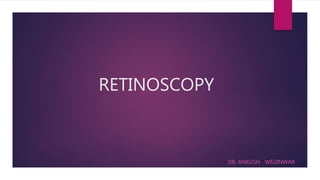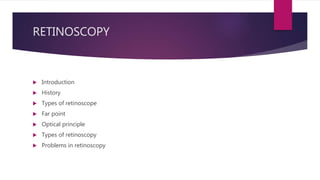Retinoscopy is a technique used to objectively measure the refractive error of the eye. Light is directed into the patient's eye to illuminate the retina, and the observer views the resulting reflex to determine the refractive state. There are different types of retinoscopes and techniques used. By observing properties of the fundal reflex such as direction and speed of motion, the observer can determine if the eye is emmetropic, hyperopic, or myopic, and approximately how much refractive error is present. Further testing is done to refine the prescription and determine any astigmatism. Retinoscopy provides an efficient initial objective refraction.

















![Optical Principle
The illumination stage
The reflex stage
The projection stage
PRE-REQUISITES-
a. Semi-dark Room
b. Trial set
c. Lens Rack
d. Trial Frame
e. Phoropter or Refractor
f. Fixating targets [distance & near charts, illuminating source]](https://image.slidesharecdn.com/retinoscopy-170327114702/85/Retinoscopy-18-320.jpg)

































